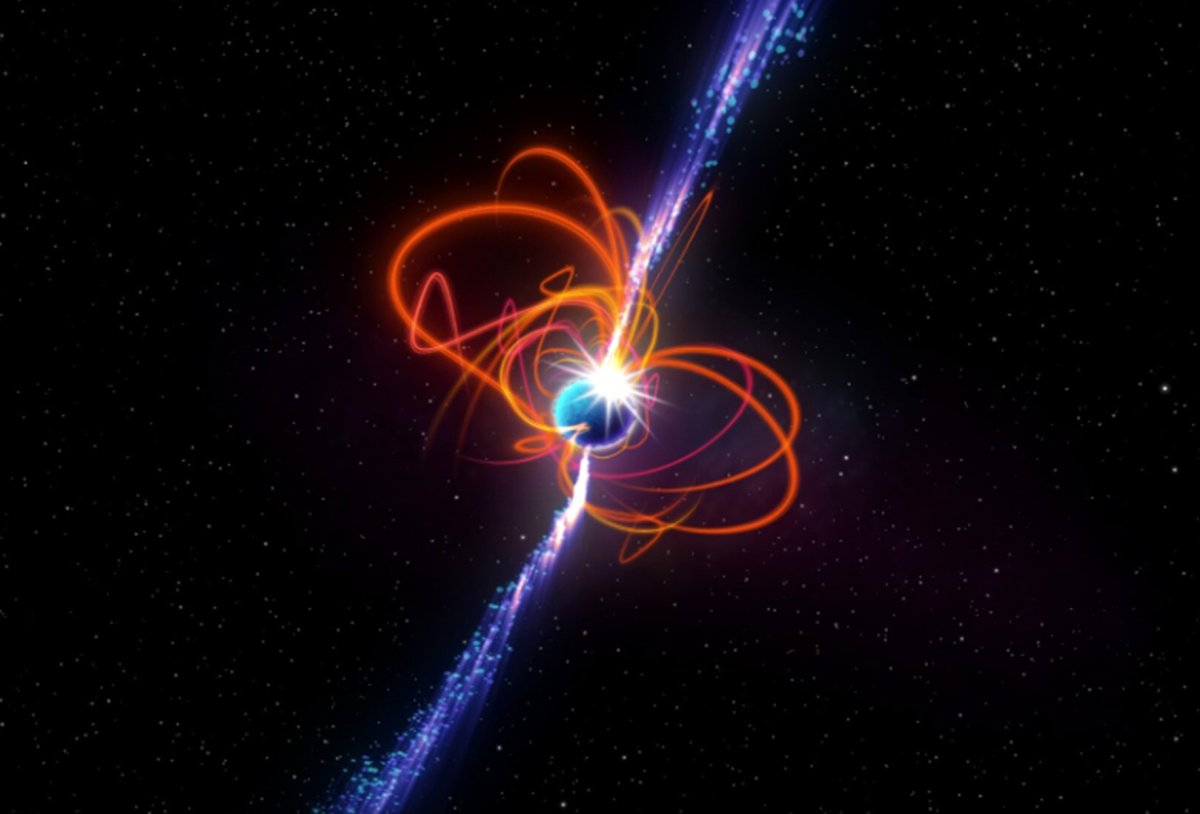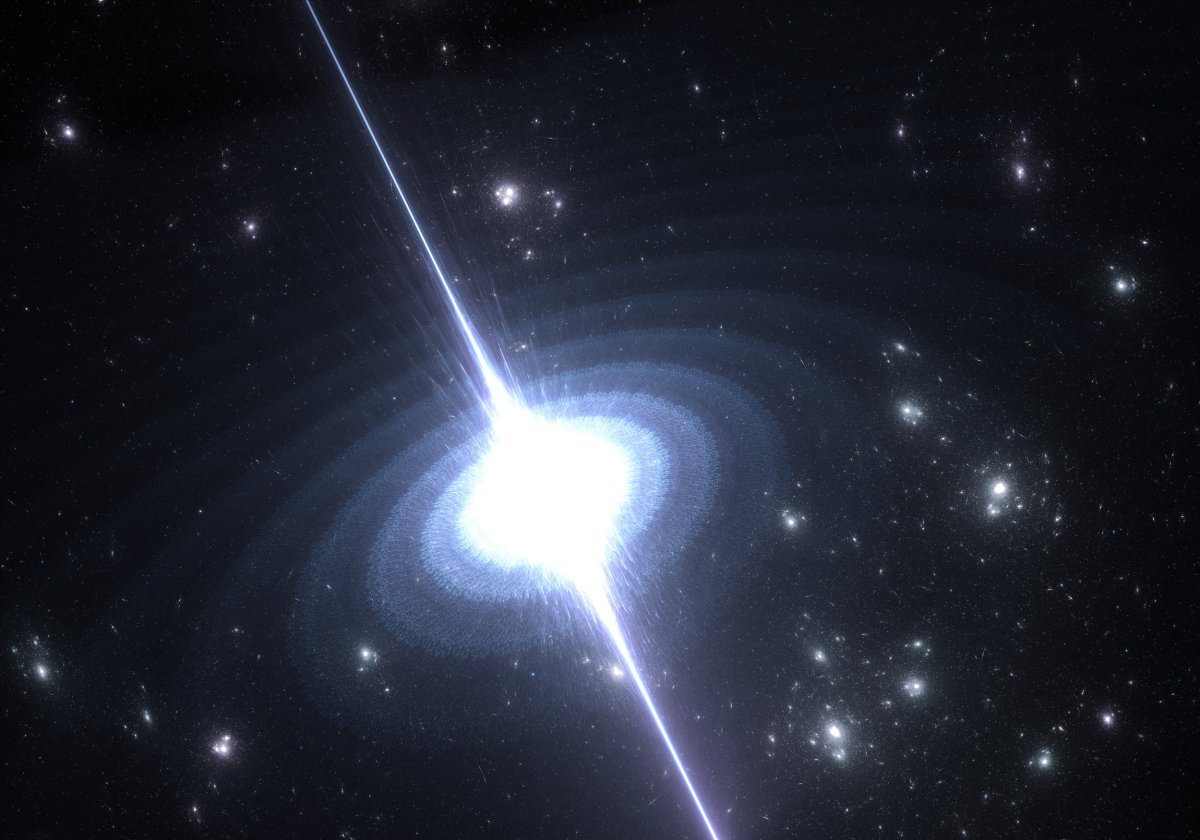A bizarre spinning object has been detected sending out strange radio wave pulses deep in space.
This object, named GPM J1839-10, is around 15,000 light years away from Earth, and has been spotted by astronomers as it shoots out powerful jets of radio waves every 22 minutes.
This finding is unusual, as objects that send out radio wave pulses in space usually pulse around once every second. This object is also unique in that we have been detecting its signals for nearly 30 years, since at least 1988, but have only noticed them now, according to a paper published in the journal Nature on July 19.

The astronomers think that this object may be a particularly slow-spinning magnetar, which are neutron stars with extremely powerful magnetic fields, usually around 12 miles in with a mass about 1.4 that of our sun. They are formed by the collapse of huge stars of around 10-25 times the mass of our sun.
"This is absurdly slow," Natasha Hurley-Walker, an astrophysicist at Curtin University node of the International Centre for Radio Astronomy Research (ICRAR) in Australia, and co-author of the paper, told Newsweek. "Magnetars are highly magnetic, young neutron stars, usually rotating once every one or two seconds, and they produce bright X-ray emission. A handful (six out of the 30 known) occasionally produce radio emission for a few weeks to months at a time."
This finding is the second time that astronomers have spotted a magnetar spinning much slower than usual: the first was named GLEAM-X J162759.5−523504.3, and was recorded emitting radio waves every 18 minutes. This object strangely went quiet after three months of activity in 2018, with no signals being recorded from it since, and spurred on the search for other slow-spinning objects that ended up finding GPMJ1839-10.

The strange properties of GPMJ1839-10 don't quite match those of a usual magnetar, however.
"For GLEAM-XJ1627, we thought that this temporary radio emission might be a good fit to what we saw. But GPMJ1839-10 really challenges that interpretation," Hurley-Walker said. "We've observed it producing bright radio pulses while we simultaneously observed with XMM-Newton, a powerful X-ray space telescope. We saw no X-rays; if it were a magnetar, we would expect to see them. And magnetars aren't normally active for decades, while GPMJ1839-10 has been producing radio pulses since at least 1988."
Usually, neutron stars like pulsars and magnetars spin extremely quickly, and are slowing down, converting rotational energy to radio waves.
"We have measured how much GPMJ1839-10 is slowing down and, to the limit of our measurement accuracy, it isn't," Hurley-Walker said. "This puts it below 'the death line,' which is our theoretical expectation of where neutron stars spin too slowly and are barely decelerating, and should stop producing radio waves. That's why the discovery has been published in Nature—our existing theories can't explain how a neutron star could produce this radio emission while spinning so slowly, let alone keep it up for decades."
Another suggestion that the astronomers have for what exactly GPMJ1839-10 could be is a very magnetic white dwarf star, which are the cores of collapsed stars that aren't massive enough to form neutron stars or black holes.
"We're also considering a scenario where a highly magnetic white dwarf might be able to produce such radio waves, but we would not expect them to be so bright, and the two white dwarfs that we know that produce radio waves are spinning much faster (2 and 5 minutes) and are each orbiting with a companion star that seems to help them generate radio emission," Hurley-Walker said. "That doesn't match the data for GLEAM-XJ1627 or GPMJ1839-10 either."
This object was only found after the astronomers began hunting for signals similar to GLEAM-XJ1627.
"We used the Murchison Widefield Array radio telescope to search ten thousand square degrees of our Milky Way galaxy twice a week, from June to September 2022. And for the first half of 2022, we massively improved our detection techniques so we'd be ready to deal with the data and pick out these faint signals," Hurley-Walker said.

They found that they had been picking up signals from GPMJ1839-10 for decades, but had only noticed it now.
"The real surprise was then finding it in the archives of much older radio telescopes, like the Very Large Array and the Giant Metrewave Radio Telescope. Other observers had looked at that patch of sky for other reasons, and not noticed GPMJ1839-10 pulsing. This is very likely because those astronomers were doing other kinds of work—they were making deep images of other objects in our Milky Way, stacking all the data together," Hurley-Walker said.
"It's more expensive to slice up the data into many time intervals and make images of each one, and no one would have had the computing resources, or the motivation! After all, until we discovered GLEAM-XJ1627, we didn't even know such things were there waiting to be found."
More research needs to be done to figure out exactly what these two possible magnetars truly are, why they spin so slowly, and why GLEAM-X J162759.5−523504 stopped sending out signals.
"I think it shows that this is a diverse class of objects and we will gain a lot from searching our archives for more, as well as planning new campaigns to search for them in creative ways. I'm really looking forward to what the astronomical community comes up with now that the paper is published," Hurley-Walker said.
Do you have a science story to share with Newsweek? Do you have a question about magnetars? Let us know via science@newsweek.com.
Uncommon Knowledge
Newsweek is committed to challenging conventional wisdom and finding connections in the search for common ground.
Newsweek is committed to challenging conventional wisdom and finding connections in the search for common ground.
About the writer
Jess Thomson is a Newsweek Science Reporter based in London UK. Her focus is reporting on science, technology and healthcare. ... Read more
To read how Newsweek uses AI as a newsroom tool, Click here.





